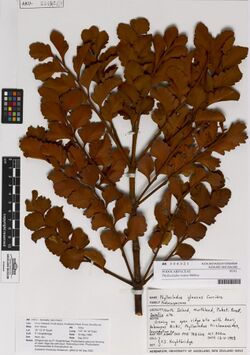Biology:Phyllocladus toatoa
| Phyllocladus toatoa | |
|---|---|

| |
| Scientific classification | |
| Kingdom: | Plantae |
| Clade: | Tracheophytes |
| Clade: | Gymnospermae |
| Division: | Pinophyta |
| Class: | Pinopsida |
| Order: | Araucariales |
| Family: | Podocarpaceae |
| Genus: | Phyllocladus |
| Species: | P. toatoa
|
| Binomial name | |
| Phyllocladus toatoa Molloy
| |
Phyllocladus toatoa, known as toatoa (Māori) or blue celery pine[2] is a species of conifer in the family Podocarpaceae, endemic to New Zealand. It was formerly referred to as P. glaucus.[3]
Botanical description
Phyllocladus toatoa is a small, dioecious or monoecious, conical or bushy tree that grows to 15 m (49 ft) in height and 60 cm (24 in) in diameter at maturity on average.[2] The outer bark ranges in color from dark brown to a silvery-brown.[3] P. toatoa is distinguishable from other species in the genus Phyllocladus due to its whorled pinnate phylloclades with diamond-shaped segments.[2] Attached to whorled branches are cladodes.[4] P. toatoa flowers between October and December, leading to a fruiting stage between January and March.[5] The fruit is a nut sitting in a cup shaped envelope.[4] Each fruit contains 3-4 3 mm square shaped seeds which are black at maturity.[3] Cultivated mature plants flower annually.[3] The species is wind pollinated by male cones which produce large quantities of pollen.[3] Seeds are black.[6] Mature seeds are dispersed from the cone through swelling of the cone bracts ejecting the seeds to the ground.[3] Distribution is limited, resulting in many seeds landing on the ground under the female tree.[3] Establishment of the species over a large area indicates that P. toatoa is dispersed by wind and birds.[3] P. toatoa is difficult to propagate and is relatively slow growing.[7]
Distribution
This species is endemic to New Zealand and is found in the North Island.[6]
Range and habitat
Phyllocladus toatoa can be found in lowlands and montane forests including the central North Island and northwards.[3] It is considered to be well protected and not considered threatened.[3] Due to its tolerance of infertile soils, it can be found on exposed ridges, around bog margins, and other poorly drained land in New Zealand.[8] The preferred habitat is that of a temperate climate with well-drained, moist soil, where roots are partially shaded and foliage is exposed to sun.[5]
References
- ↑ Farjon, A. (2013). "Phyllocladus toatoa". IUCN Red List of Threatened Species 2013: e.T42268A2968438. doi:10.2305/IUCN.UK.2013-1.RLTS.T42268A2968438.en. https://www.iucnredlist.org/species/42268/2968438. Retrieved 16 November 2021.
- ↑ Jump up to: 2.0 2.1 2.2 Earle, Christopher J.. "Phyllocladus toatoa Molloy 1996". http://forestis.rsvs.ulaval.ca/www.botanik.uni-bonn.de/conifers/po/ph/toatoa.htm. [|permanent dead link|dead link}}]
- ↑ Jump up to: 3.0 3.1 3.2 3.3 3.4 3.5 3.6 3.7 3.8 3.9 Molloy, B. P. J. (31 January 2012). "A new species name in Phyllocladus". New Zealand Journal of Botany 34 (3): 287–297. doi:10.1080/0028825X.1996.10410695.
- ↑ Jump up to: 4.0 4.1 "Phyllocladaceae". http://cber.bio.waikato.ac.nz/courses/226/Gymnosperms/Phyllocladaceae.html.
- ↑ Jump up to: 5.0 5.1 "NZ Plant Conservation Network". New Zealand Plant Conservation Network. http://www.nzpcn.org.nz/flora_details.asp?ID=1116.
- ↑ Jump up to: 6.0 6.1 Eagle, Audrey (2008) (in English). Eagle's complete trees and shrubs of New Zealand volume one. Wellington: Te Papa Press. pp. 30. ISBN 9780909010089. https://www.wikidata.org/wiki/Q63848025.
- ↑ "Non-Flowering seed plants: Native conifers". http://web.auckland.ac.nz/uoa/science/about/departments/sbs/newzealandplants/seed-plants-nonflowering/native-conifers/phyllocladaceae-celery-pine/toatoa.cfm.
- ↑ "Takana Native Trees". Takana Nursery. http://www.takana.co.nz/trees/item/phyllocladus-toatoa.
Wikidata ☰ Q5409422 entry
 |


